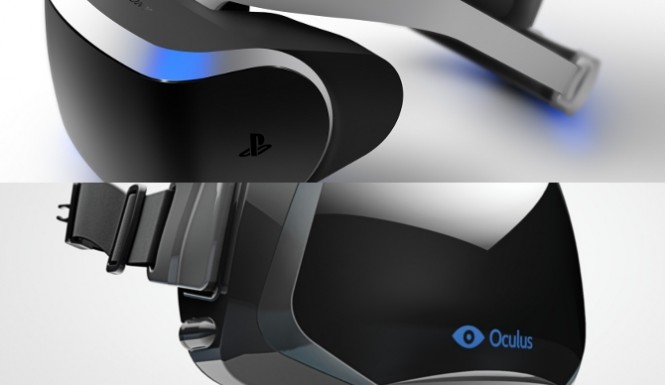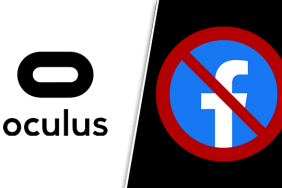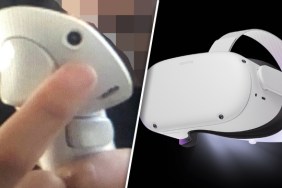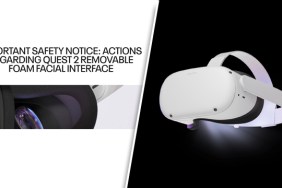Project Morpheus has arrived as a thundering giant: a device released with the bold statement that virtual reality is the future of gaming and that Sony plans to dive into it, humbly asking developers to go with the company. However, with Facebook's acquisition of the noted VR Oculus Rift hardware—with promises from Oculus founder Palmer Luckey that the device is still being created for games—it has again grasped the spotlight. So how do the two compare?
Getting hands-on with the Oculus Rift’s prototype for its 1080p dev kit at GDC this year, I found it easy to see how far it’s come. Boasting higher resolution than its previous 720p kit makes the images much more clear (though the Oculus devs are reportedly already looking forward to 4K displays for future tech). It has also changed slightly, as the original Rift had a wider angle of view, allowing for a greater sense of immersion at the cost of lower resolution.
Oculus still has a wider view than Project Morpheus, which is locked at 90 degrees, so it feels like looking through scuba goggles at the virtual world. This means that Oculus is slightly more immersive visually than Morpheus, but it's also just slightly lower res. This also gave the Oculus demo produced by Epic—a 3D fighter with cartoony characters called Couch Knights—a bit more of a real and lived-in feel than any of the Project Morpheus demos, but it was blurrier towards the edges of the screen.
At GDC 2014, both devices sported a demo for EVE: Valkyrie and comparing the two would make Sony appear to come out on top, except that the Oculus demo for the game was clearly an earlier version. It didn’t have all of the HUD elements worked out, was slower-paced, lacked environmental elements, and some gameplay, so it’s more than a bit of an unfair comparison. But that might be part of what drives potential success to Sony’s device; while passing by some Oculus executives, I overheard one of them telling another about Sony’s easier access to developers.
On the flipside, the initial Oculus Rift dev kit has been available to developers for some time now, and there are forums and software designed specifically to give existing games support for third-party VR headsets. Valve even has native support for some of its games in VR, highlighting the Oculus as a device. On the PC end, VR may be driven by a mix of first-party support, modders, and tinkerers who convert non-native games after the fact. Add to that Facebook's support of the device, and at the very least we should see horrible VR ports of Farmville and other casual-gaming atrocities (I kid, I kid).
This may also be why the Oculus Rift and Project Morpheus have such a cordial relationship with each other: They don’t see each other as competitors. One of the Project Morpheus developers told me it was all the same tech, and they were all happy to try and figure it out together (though I wonder if this will continue to be the case when Microsoft—or perhaps Nintendo—reveals their VR systems and headsets… maybe). Similarly, an Oculus executive (who was standing in the same line as myself to see Project Morpheus) told me that they saw the VR development world as being a kind of fraternity, where they were all looking for success.
On performance, aside from the viewing angle and resolution, the biggest differences between the two devices may be their methods of determining headtracking and its reliability. In addition to their internal motion-sensing components, they both also have external camera trackers to aid in positional tracking. Project Morpheus works in conjunction with the Playstation Camera, which uses its two cameras, and one can make the conjecture that four blue LEDs on the front of the head-mounted display and two on the back are used to track the device. The Oculus uses a set of infrared lights set behind the plastic carapace (which the infrared light just punches through) and an infrared camera.
A PR Manager told me that the Oculus units have a way of sending an individual identity code with the infrared data, so one unit won’t be confused with another when in the same room (Oculus LAN party, anyone?). While I didn’t ask, I can assume this isn’t a problem for Project Morpheus, which is only meant to have one headset paired with the PlayStation 4, so it doesn’t need a method of differentiating between them since very few people have two of the same console in the same room. This is also most likely why the Playstation 4 controller has a blue light when active, so it can be accurately tracked to properly identify the body position of the player’s arms.
In terms of fit, the Oculus is more snug, sitting tighter on the face. This might seem advantageous, but it’s a real problem for people who wear glasses, mashing them into the face in order to fit inside the head-piece. This is one area where Project Morpheus has a definite advantage. The Oculus Rift is definitely a device to wear contact lenses while in use if you have a prescription, while Project Morpheus doesn’t have these issues as the device can fit comfortably around glasses, provided they aren’t extravagantly large.
Both pieces of tech will only have better implementation in the future. At Sony's press conference, there was discussion about this being the start of innovation for virtual reality, and it seems clear that Sony is willing to spend money not just to make that happen, but to make it happen at the consumer level for gamers, having designed features on PS4 and its peripherals that appear to have been designed with VR in mind. The might of Sony's R&D division is behind Project Morpheus, and Sony PR people have been encouraged to discuss where Sony's existing product lines gave the team a headstart on sound and video hardware production.
With Facebook providing $2 billion dollars, though, Oculus has the firepower to go head-to-head with Sony in terms of tech and specs than it was previously capable. The Rift's prior specs had been developed from adapted cellphone tech. Founder Palmer Luckey has responded to dismayed comments on the story of Oculus's acquisition on Reddit, that the influx of money will allow them to increase its ability to lose the reliance on mobile tech and to increase its ability to draw more content to the device. However, neither of these devices may emerge o -top when it comes to VR and augmented gaming experiences.
The Avegant Glyph, for instance, is another piece of prominent tech that uses a different optical system to project the visuals directly onto the retina (like having a pair of miniature projectors that beam the image directly into your eyeballs). It has greater image fidelity than either the Oculus Rift or Project Morpheus. Even though the Glyph is intended more as a media viewer than a VR device and has a narrower field of view of 45 degrees, it still boasts headtracking and can be connected to devices with a single cable. While not virtual, Google Glass realizes the integration of wearable computing transmitted visually into the real world, and we have yet to see the Augmented Reality of such a device played out with gaming.
With the tech in the middle of a period of expansion that will create a greater sense of immersion for gamers, it's difficult to say where things may go. However, one thing that's certain is that everyone is pushing for experiences that make games feel more vital, personal, and intuitive in their experience. If those experiences can be made available cheaply and accessibly to consumers, bring them on!











